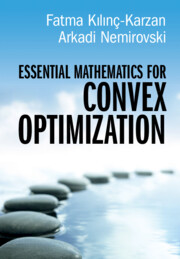Refine search
Actions for selected content:
1550 results in Control systems and optimization
Control Systems Theory
- Coming soon
-
- Expected online publication date:
- March 2026
- Print publication:
- 01 May 2027
-
- Textbook
- Export citation

Introduction to Online Control
- Coming soon
-
- Expected online publication date:
- January 2026
- Print publication:
- 31 January 2026
-
- Book
- Export citation

Essential Mathematics for Convex Optimization
-
- Published online:
- 22 October 2025
- Print publication:
- 26 June 2025
-
- Textbook
- Export citation
18 - ★ Convex Programming in Cone-Constrained Form
- from Part IV - Convex Programming, Lagrange Duality, Saddle Points
-
- Book:
- Essential Mathematics for Convex Optimization
- Published online:
- 22 October 2025
- Print publication:
- 26 June 2025, pp 252-263
-
- Chapter
- Export citation
23 - Exercises for Part IV
- from Part IV - Convex Programming, Lagrange Duality, Saddle Points
-
- Book:
- Essential Mathematics for Convex Optimization
- Published online:
- 22 October 2025
- Print publication:
- 26 June 2025, pp 307-341
-
- Chapter
- Export citation
Copyright page
-
- Book:
- Essential Mathematics for Convex Optimization
- Published online:
- 22 October 2025
- Print publication:
- 26 June 2025, pp iv-iv
-
- Chapter
- Export citation
19 - Optimality Conditions in Convex Programming
- from Part IV - Convex Programming, Lagrange Duality, Saddle Points
-
- Book:
- Essential Mathematics for Convex Optimization
- Published online:
- 22 October 2025
- Print publication:
- 26 June 2025, pp 264-276
-
- Chapter
- Export citation
Contents
-
- Book:
- Essential Mathematics for Convex Optimization
- Published online:
- 22 October 2025
- Print publication:
- 26 June 2025, pp v-xii
-
- Chapter
- Export citation
Appendix D - Prerequisites: Symmetric Matrices and Positive Semidefinite Cone
-
- Book:
- Essential Mathematics for Convex Optimization
- Published online:
- 22 October 2025
- Print publication:
- 26 June 2025, pp 401-424
-
- Chapter
- Export citation
Preface
-
- Book:
- Essential Mathematics for Convex Optimization
- Published online:
- 22 October 2025
- Print publication:
- 26 June 2025, pp xiii-xvi
-
- Chapter
- Export citation
10 - How to Detect Convexity
- from Part III - Convex Functions
-
- Book:
- Essential Mathematics for Convex Optimization
- Published online:
- 22 October 2025
- Print publication:
- 26 June 2025, pp 158-174
-
- Chapter
- Export citation
Appendix B - Prerequisites from Real Analysis
-
- Book:
- Essential Mathematics for Convex Optimization
- Published online:
- 22 October 2025
- Print publication:
- 26 June 2025, pp 366-383
-
- Chapter
- Export citation
Main Notational Conventions
-
- Book:
- Essential Mathematics for Convex Optimization
- Published online:
- 22 October 2025
- Print publication:
- 26 June 2025, pp xvii-xviii
-
- Chapter
- Export citation
Appendix A - Prerequisites from Linear Algebra
-
- Book:
- Essential Mathematics for Convex Optimization
- Published online:
- 22 October 2025
- Print publication:
- 26 June 2025, pp 342-365
-
- Chapter
- Export citation
References
-
- Book:
- Essential Mathematics for Convex Optimization
- Published online:
- 22 October 2025
- Print publication:
- 26 June 2025, pp 425-425
-
- Chapter
- Export citation
Appendix C - Prerequisites from Calculus
-
- Book:
- Essential Mathematics for Convex Optimization
- Published online:
- 22 October 2025
- Print publication:
- 26 June 2025, pp 384-400
-
- Chapter
- Export citation
Appendices
-
- Book:
- Essential Mathematics for Convex Optimization
- Published online:
- 22 October 2025
- Print publication:
- 26 June 2025, pp 342-424
-
- Chapter
- Export citation
3 - Polyhedral Representations and Fourier–Motzkin Elimination
- from Part I - Convex sets in Rn: From First Acquaintance to Linear Programming Duality
-
- Book:
- Essential Mathematics for Convex Optimization
- Published online:
- 22 October 2025
- Print publication:
- 26 June 2025, pp 38-44
-
- Chapter
- Export citation
20 - ★ Cone-Convex Functions: Elementary Calculus and Examples
- from Part IV - Convex Programming, Lagrange Duality, Saddle Points
-
- Book:
- Essential Mathematics for Convex Optimization
- Published online:
- 22 October 2025
- Print publication:
- 26 June 2025, pp 277-283
-
- Chapter
- Export citation
Part IV - Convex Programming, Lagrange Duality, Saddle Points
-
- Book:
- Essential Mathematics for Convex Optimization
- Published online:
- 22 October 2025
- Print publication:
- 26 June 2025, pp 233-341
-
- Chapter
- Export citation
